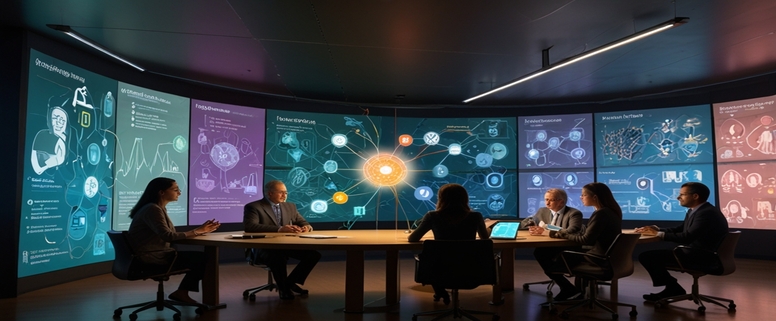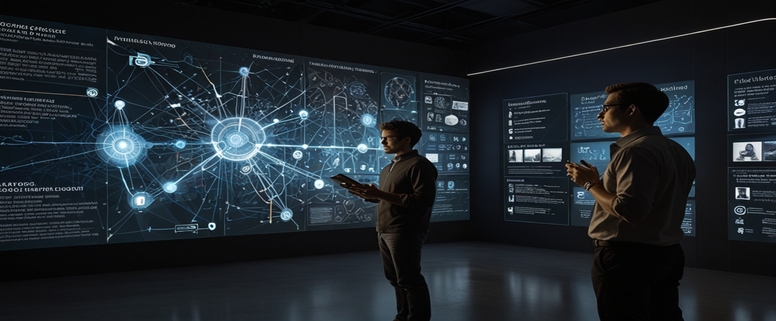Introduction: Between Science and Mediation
The greatest challenges we face as a society—from climate change to technological ethics, from healthcare access to educational inequality—aren't simply technical problems awaiting technical solutions. They are complex socio-technical challenges requiring both rigorous scientific understanding and skilled human mediation. These challenges exist at the intersection of what we know and how we communicate, collaborate, and make collective decisions based on that knowledge.
This intersection is precisely where I've found my own purpose and approach—what my MARCO profile identified as the "Scientific Mediator." This orientation combines analytical problem-solving with a cooperative, helpful nature—a profile comparable to Gandhi's approach of leading through non-violent action and mediation rather than confrontation.
In our increasingly polarized and information-saturated world, the role of Scientific Mediator becomes crucial. Technology, when thoughtfully designed and deployed, can serve as a powerful bridge—connecting people with information, knowledge with application, and diverse perspectives with shared understanding. Yet the same technologies can also deepen divides, reinforce biases, and overwhelm our collective sense-making capacities when misused.
This article explores the Scientific Mediator orientation and how technology can be designed to amplify this approach—creating more effective bridges between people and knowledge, fostering cooperation rather than competition, and helping transform information abundance into genuine wisdom and understanding.
The Scientific Mediator Profile
The Scientific Mediator profile represents a unique combination of characteristics that blend analytical rigor with cooperative human connection. According to my MARCO assessment, this profile is characterized by several key qualities:
Key Qualities of the Scientific Mediator
Analytical Problem-Solving
A natural tendency to understand problems through logical, rational solutions. Scientific Mediators enjoy theoretical questioning, gathering information, analyzing data, and solving complex problems with systematic approaches.
Cooperative Spirit
A strong sense of teamwork and cooperation. Rather than competitive approaches, Scientific Mediators prefer activities where they can help others and solve complex problems collaboratively.
Perceptive Understanding
An ability to perceive patterns and understand complex systems, coupled with a sympathetic approach to conflict resolution that emphasizes understanding and empathy.
Teaching Orientation
Scientific Mediators often work best in teaching and roles related to sciences and the social sector, where explaining complex ideas and helping others understand them is central.
This profile resonates deeply with my experiences and approach. Throughout my career transitions from hospitality management to cybersecurity and educational technology, I've consistently found myself drawn to roles that involve both understanding complex systems and helping others navigate them. The satisfaction comes not just from solving technical problems but from making those solutions accessible and meaningful to others.
The Scientific Mediator orientation isn't merely a personality trait but an approach to engaging with the world that has particular relevance in our current context. As information abundance grows and technical complexity increases, we face a widening gap between specialized knowledge and public understanding. Meanwhile, as social media algorithms prioritize engagement over understanding, our collective capacity for nuanced, evidence-based dialogue deteriorates. Scientific Mediators help bridge these divides—translating specialized knowledge into accessible insights while facilitating the human connections necessary for collective action.
Building Bridges of Understanding
The Scientific Mediator approach to technology design and use focuses on building bridges across three critical divides that characterize our current information landscape:
Critical Divides
The Expertise Divide
The growing gap between specialized expert knowledge and general public understanding. As fields become increasingly specialized, experts struggle to communicate their insights in accessible ways, while non-experts struggle to evaluate competing claims.
The Attention Divide
The split between deep, focused engagement with complex ideas and the fragmented, surface-level attention that characterizes much of our digital information consumption.
The Perspective Divide
The increasingly segregated information environments that separate people with different viewpoints, making shared understanding and collaborative problem-solving more difficult.
Technology can either widen or narrow these divides depending on its design and use. Social media algorithms that prioritize engagement often widen them by amplifying simplified, emotionally provocative content rather than nuanced understanding. Search engines that prioritize personalization can create filter bubbles that reinforce existing perspectives rather than expanding them.
Yet technology can also be deliberately designed to build bridges across these divides:
Technology as a Bridge Builder
Knowledge Translation Tools
Systems that help translate specialized knowledge into accessible formats without sacrificing accuracy or nuance. These range from interactive visualizations of complex data to AI-assisted explanation systems that adapt to different background knowledge levels.
Attention Enhancement Technologies
Tools that support sustained, focused engagement with complex ideas rather than distracting from it. These include reading environments designed for deep focus, annotation systems that support active engagement with content, and notification management systems that protect attention.
Perspective-Bridging Platforms
Environments designed to help people understand different viewpoints rather than simply arguing from fixed positions. These platforms emphasize finding common ground, identifying shared values beneath disagreements, and building collaborative understanding.
In my own work developing educational tools like MathSage and the "Learning is Fun" platform, I've focused on bridging these divides—creating systems that make complex subjects accessible without oversimplification, support sustained attention appropriate to diverse cognitive styles, and help connect different perspectives on learning and knowledge.

Technology as a Knowledge Connector
The most powerful technologies for Scientific Mediation don't simply transfer information but connect knowledge in ways that create new understanding. This connection happens across multiple dimensions:
Dimensions of Knowledge Connection
Cross-Domain Knowledge Integration
Technologies that help identify relationships between seemingly separate fields or domains. These systems reveal how insights from one area might inform challenges in another, supporting the interdisciplinary thinking essential for complex problem-solving.
Theory-Practice Connection
Tools that bridge the gap between theoretical understanding and practical application. These range from simulation environments that allow exploring theoretical principles in practical contexts to implementation guidance systems that translate general principles into specific actions.
Individual-Collective Knowledge Bridging
Systems that help transform individual insights into collective understanding and vice versa. These include collaborative knowledge bases, group sense-making tools, and platforms that help synthesize diverse individual perspectives into coherent shared models.
Past-Future Knowledge Linkage
Technologies that connect historical understanding with future possibilities. These tools help identify patterns from past experiences that might inform future scenarios, while avoiding simplistic extrapolation.
The Scientific Mediator approach to these knowledge connections emphasizes human-centered design that keeps people—their needs, capabilities, and values—at the center of the technological system. Rather than treating technology as an autonomous solution, this approach sees it as a tool for enhancing human connection with knowledge and with each other.
In practice, this might look like educational platforms that adapt not just to individual learning styles but to the relationships between different knowledge domains relevant to the learner's goals. Or collaboration systems that help teams identify how their diverse expertise areas connect to the problem at hand, making complementary knowledge more visible and accessible.
The Human-Information Interface
At the core of Scientific Mediation is the human-information interface—the point where people interact with knowledge. This interface encompasses not just user interface design but the deeper question of how people form meaningful relationships with information.
Several principles guide effective human-information interfaces from a Scientific Mediator perspective:
Principles of Effective Human-Information Interfaces
Cognitive Appropriateness
Interfaces should match how human cognition naturally processes information rather than forcing unnatural interaction patterns. This includes supporting different cognitive styles and addressing the limitations of human working memory and attention.
Progressive Disclosure
Information should be structured to reveal appropriate complexity at each stage of understanding, allowing users to "zoom in" for deeper detail or "zoom out" for broader context as needed.
Active Engagement
Interfaces should support active rather than passive information processing, encouraging users to question, connect, and apply knowledge rather than merely consuming it.
Meaningful Context
Information should be presented within frameworks that help users understand its significance, relationships, and implications rather than as isolated facts.
Feedback Integration
Interfaces should provide appropriate feedback that helps users refine their understanding and correct misconceptions without creating unnecessary frustration or confusion.
In my work with neurodivergent learners, I've found that these principles become even more crucial. Different cognitive styles—whether related to ADHD, dyslexia, or other variations—often involve different optimal interfaces with information. Some learners benefit from highly visual, spatial representations, while others need sequential, structured presentation. Some thrive with interactive, hands-on information exploration, while others need quiet reflection.
Effective Scientific Mediation requires technologies that accommodate this diversity rather than imposing a single interface model on all users. This approach doesn't simply make information more accessible to diverse users; it often reveals new insights by enabling different ways of engaging with the same knowledge.
From Information to Wisdom
Perhaps the most important function of Scientific Mediation is helping transform raw information into genuine wisdom. In an age of information abundance, our challenge isn't accessing information but developing the discernment, context, and judgment to use it wisely.
Technology can support this transformation through several approaches:
Approaches to Transforming Information into Wisdom
Knowledge Hierarchies
Systems that help organize information into meaningful hierarchies—from raw data to structured information to contextual knowledge to applicable wisdom. These hierarchies help users understand not just individual facts but their significance within broader understanding.
Truth Evaluation Tools
Technologies that support critical evaluation of information quality, helping users assess reliability, methodology, bias, and limitations of different information sources without requiring specialist expertise in every domain.
Value Integration Systems
Tools that help connect information with relevant values and ethical considerations, supporting not just technical understanding but wisdom about how knowledge should be applied in human contexts.
Consequence Exploration
Technologies that help model and explore the potential consequences of applying knowledge in different ways, supporting wiser decision-making by making implications more visible.
These approaches share a common thread: they treat wisdom not as something technology provides but as something technology helps people develop through their own discernment and judgment. The Scientific Mediator role isn't to replace human wisdom with algorithmic decision-making but to create environments where human wisdom can flourish even amid information complexity.
In my experience developing educational AI, I've found that the most valuable systems don't simply deliver answers but help users develop their own understanding. The MathSage system, for example, distinguishes between providing solutions (which short-circuits learning) and guiding conceptual understanding (which builds genuine knowledge). This distinction between information delivery and wisdom development lies at the heart of Scientific Mediation.

A Framework for Cooperation
The Scientific Mediator approach culminates in a framework for using technology to foster cooperation and knowledge sharing rather than competition and knowledge hoarding. This framework operates at three levels:
Framework for Cooperation
Individual Level
Tools and practices that help individuals develop both the technical understanding and the communication skills necessary for effective knowledge sharing. These include not just knowledge organization systems but also technologies that support explanation, translation of expertise, and empathetic communication.
Group Level
Platforms and processes that support collaborative knowledge building within teams, organizations, and communities. These systems emphasize making diverse knowledge visible, integrating different perspectives, and supporting collective sense-making rather than merely aggregating individual opinions.
Societal Level
Infrastructures and institutions that enable broad knowledge sharing across traditional boundaries of discipline, organization, and geography. These include open knowledge repositories, translation systems that bridge specialized vocabularies, and governance models that balance openness with quality control.
Practical implementation of this framework might include:
1. Knowledge Commons: Creating and maintaining shared knowledge resources that combine rigorous expert input with accessible explanation and application guidance.
2. Collaborative Sense-Making Tools: Developing technologies specifically designed to help diverse groups integrate their understanding of complex challenges rather than simply debating fixed positions.
3. Bridge-Building Roles: Establishing and supporting roles specifically focused on connecting different knowledge communities—from science communicators to cross-disciplinary translators to community knowledge stewards.
4. Inclusive Design Principles: Ensuring knowledge technologies are designed with diverse users in mind, accommodating different cognitive styles, cultural contexts, and access needs.
This framework doesn't impose a single model of cooperation but creates the conditions where diverse forms of collaboration can emerge based on the specific context and needs. The Scientific Mediator's role isn't to dictate cooperation but to facilitate it by removing barriers and creating appropriate infrastructure.
Conclusion: Becoming Bridges
In a world increasingly divided by information bubbles, specialized expertise, and polarized discourse, the Scientific Mediator orientation offers a vital perspective on technology's potential. Rather than seeing technology primarily as a tool for efficiency, competition, or control, this approach reconceives it as a means for building bridges—between people and knowledge, between different ways of knowing, and between diverse communities seeking shared understanding.
This perspective doesn't deny technology's power but redirects it toward human connection rather than division, toward wisdom rather than mere information accumulation, and toward cooperation rather than zero-sum competition.
As someone identified with the Scientific Mediator profile, I've found my greatest satisfaction not in technical mastery alone but in helping make complex knowledge accessible and meaningful to others. Whether in education, cybersecurity, or other domains, the moments of genuine connection—when understanding bridges are successfully built—provide the deepest sense of purpose and contribution.
The technologies we create reflect our values and assumptions. By consciously designing from a Scientific Mediator perspective, we can develop tools that amplify our capacity for understanding, collaboration, and wise action in an increasingly complex world. In doing so, we don't just create better technologies—we create better relationships between people and knowledge, and ultimately, between people themselves.
The future belongs not to those who accumulate the most information or the most powerful technologies, but to those who can build the strongest bridges between technical understanding and human needs, between specialized expertise and public wisdom, and between diverse perspectives and shared action. By embracing the Scientific Mediator orientation in both our personal approach and our technological design, we can help create that more connected future.





